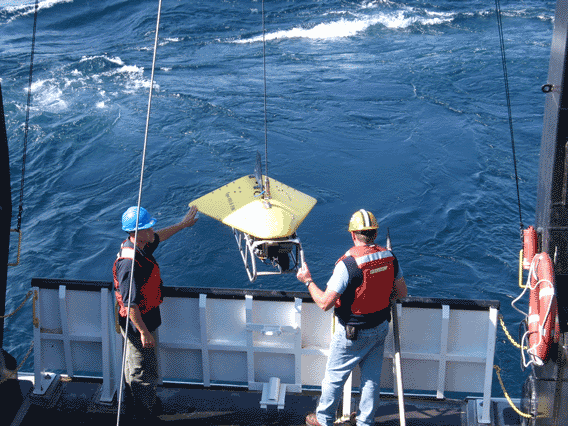Optically Acquired Zooplankton Data as an Indicator for Condition in the Great Lakes
Project Summary

A Laser-Optical Plankton Counter (LOPC) can be towed behind a ship and has the potential to be used as a tool to measure in situ the zooplankton trophic level for food web monitoring and assessment. An LOPC provides the raw data for determining mean size, abundance, and biomass, and additionally provides information on the zooplankton community distribution and size structure. Also, the statistical and spatial problems posed by the expanse of the Great Lakes, even on a regional basis, can be reduced by high density LOPC data (every 0.5 seconds) across many kilometers of towing. This project is investigating the feasibility and the economics of using an LOPC to provide measures of biomass and size-structure of the Great Lakes zooplankton community as parameters to be used as indicators. Our goal is to determine if an LOPC can be used to reliably measure, characterize, and differentiate zooplankton communities within the Great Lakes. This project will also help to define the spatial variability in the open waters of the Great Lakes for improving assessment and monitoring design strategies, because of the spatial information imbedded in data from the LOPC and associated instrumentation.
Key products
VanAlstine, J., P.M. Yurista, J.R. Kelly, and S.E. Miller. Poster presentation: Lake Michigan: Nearshore variability. 54th IAGLR Conference, Duluth, MN, May 30-June 3, 2011.
Yurista, P.M. and J.R. Kelly. 2009. Spatial patterns of water quality and plankton from high-resolution continuous in situ sensing along a 537-km nearshore transect of western Lake Superior, 2004. In M. Munawar and I.F. Munawar, Eds., State of Lake Superior. Ecovision World Monograph Series, Aquatic Ecosystem Health & Management Society, Canada, pp. 439-471.
Yurista, P.M., J.R. Kelly, and S.E. Miller. 2009. Lake Superior zooplankton biomass: Alternate estimates from a probability-based net survey and spatially-extensive LOPC surveys. Journal of Great Lakes Research 35:337-346.
Yurista, P.M., J.R. Kelly, and S.E. Miller. 2006. Comparisons of zooplankton community size structure in the Great Lakes. Journal of Geophysical Research – Oceans Special Issue 111, C05S08, doi:10.1029/2005JC002971:1-12.
Yurista, P.M., J.R. Kelly, and S.E. Miller. 2005. Evaluation of optically acquired zooplankton size-spectrum data as a potential tool for assessment of condition in the Great Lakes. Environmental Management 35(1):34-44.
Yurista, P.M., J.R. Kelly, S.E. Miller, and J. Van Alstine. Oral presentation: Lake Superior: Linking landscape to nearshore condition. "Ecology of Lake Superior" Conference, Duluth, MN, May 3-5, 2010.
Project personnel
| Name | Phone | |
| Peder Yurista | yurista.peder@epa.gov | 218-529-5148 |
| Jack Kelly | kelly.johnr@epa.gov | 218-529-5119 |
| Sam Miller |
Research project update date
March 16, 2011
![[logo] US EPA](../gif/logo_epaseal.gif)